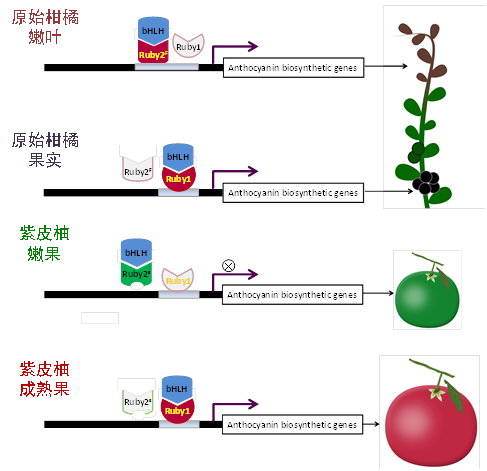
Regulatory model of anthocyanin accumulation in citrus fruits
On October 29th, Nature Plants published online the article entitled “Subfunctionalization of the Ruby2-Ruby1 Gene Cluster during the Domestication of Citrus” from HZAU Citrus Research Team led by Prof. Deng Xiuxin, with Prof. Xu Qiang as corresponding author and Dr. Huang Ding as first author.
Anthocyanin, a kind of plant secondary metabolites, belongs to the class of flavonoid. It has a positive effect on plants’ and human’s health. For plants, anthocyanin can not only help them survive from severe environments such as strong Uv or low temperature, but also assist them in attracting insects and animals for pollination and seed dispersal. As for humans, anthocyanin, with high antioxidant activity, can protect us against the damage of free radicals. With the development of citrus industry, consumers expect citrus fruits to be good in appearance and taste as well as rich in nutrition. Now, the improvement of appearance quality of citrus fruit has become a focus in citrus breeding. Anthocyanin can give the citrus a purple appearance unlike ordinary yellow or orange citrus. Therefore, it is of great theoretical and practical significance to analyze the regulation mechanism of anthocyanins in citrus and further to improve the appearance quality of citrus fruits.
The evolution of fruit color in plants is intriguing. Citrus fruit has repeatedly gained or lost the ability to synthesize anthocyanins. Chinese box orange, a primitive citrus, can accumulate anthocyanins both in fruits and in leaves. Most of the wild citrus can only accumulate anthocyanins in their leaves. In contrast, most cultivated citrus have lost the ability to accumulate anthocyanins. Wild purple pummelo of citrus variety was discovered by Prof. Deng Xiuxin and Prof. Peng Shu-Ang in Enshi Tujia and Miao Autonomous Prefecture, Hubei province. The pummelos can accumulate anthocyanins on their purple peels which are different from ordinary pummelos. The research characterized a novel MYB regulatory gene, Ruby2, which is adjacent to Ruby1, a known anthocyanin activator of citrus. Different Ruby2 alleles can have opposite effects on the regulation of anthocyanin biosynthesis. AbRuby2Full encodes an anthocyanin activator that mainly functions in the pigmented leaves of Chinese box orange. CgRuby2Short was identified in purple pummelo and encoded an anthocyanin repressor. CgRuby2Short has lost the ability to activate anthocyanin biosynthesis. However, it retains the ability to interact with the same partner, CgbHLH1, as CgRuby1, thus acting as a passive competitor in the regulatory complex. Further investigation in different citrus species indicated that the Ruby2–Ruby1 cluster exhibits subfunctionalization among primitive, wild and cultivated citrus. This study elucidated the regulatory mechanism of the Ruby2–Ruby1 cluster in citrus, and laid a good theoretical foundation for the improvement of citrus fruit appearance quality.
This research was supported by the National Natural Science Foundation of China and the Fundamental Research Funds for the Central Universities.
Resource:https://www.nature.com/articles/s41477-018-0287-6
Translated by: Yin Ruixuan
Supervised by: Guo Xiaoyan
